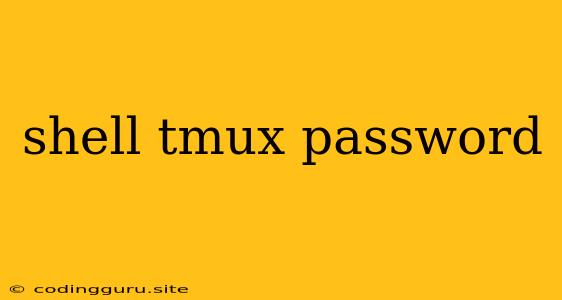Tmux, Shells, and Password Management: A Comprehensive Guide
Tmux is a powerful terminal multiplexer, allowing you to manage multiple terminal sessions within a single window. Its versatility makes it an indispensable tool for developers, system administrators, and anyone who works frequently with the command line. But what about securing your sessions, especially when dealing with sensitive information like passwords? This article explores the intersection of Tmux, shells, and password management, addressing the question of how to effectively safeguard your credentials within the Tmux environment.
Why is Password Management in Tmux Important?
While Tmux enhances your command-line experience, it's crucial to remember that it doesn't inherently provide security measures for your passwords. If you type your password directly within a Tmux session, it's visible to anyone with access to your terminal. This vulnerability becomes particularly concerning if you're working on a shared server or accessing sensitive data remotely.
Secure Practices for Managing Passwords within Tmux
Here are a few best practices to mitigate the risk of exposing your passwords within a Tmux session:
1. Use Password Managers:
Password managers like KeePass, LastPass, or 1Password are designed to securely store and manage your credentials. These tools can generate strong passwords, encrypt your data, and provide a convenient way to access your logins without typing them directly into the terminal. You can integrate your password manager with your shell or use its command-line interface to retrieve and paste passwords securely.
2. Utilize Secure Shells:
Employ secure shells like SSH to establish encrypted connections between your local machine and remote servers. SSH encrypts all communication, ensuring that your passwords and other sensitive data remain confidential during transmission.
3. Implement SSH Key-Based Authentication:
Instead of relying on passwords, SSH supports key-based authentication. This method involves generating a public and private key pair. You store the public key on the remote server, allowing your client machine to authenticate without requiring a password.
4. Leverage Environment Variables:
Store your sensitive credentials in environment variables that are accessible only within your current shell session. When you exit the session, the variables are automatically removed. This method offers a level of security compared to directly typing your passwords into the terminal.
5. Consider Tmux's Security Features:
While Tmux itself doesn't provide built-in password management capabilities, you can configure it to enhance security:
- Session Password: Configure Tmux to require a password to attach to a specific session. This helps prevent unauthorized access to your active Tmux sessions.
- Detach/Reattach: Detach from a Tmux session (using Ctrl+B d) to temporarily leave it running. When you reattach (tmux attach -t session_name), it will restore the session, ensuring that any sensitive information you entered remains within the session's environment.
6. Avoid Storing Passwords in Tmux Configuration Files:
Refrain from hardcoding passwords or sensitive information directly within your Tmux configuration file (~/.tmux.conf). This can be a security risk if someone gains access to your configuration file.
Examples and Illustrations
Let's illustrate how some of these practices work in practice:
Using a Password Manager with Tmux:
# Assuming you have a password manager like KeePass
# Store your password in a KeePass entry
# Retrieve the password using the KeePass command-line interface
keepass-cli get-entry my_website -p "my_master_password" -u "my_username" -f "my_database.kdbx" | xargs -0 echo
# The password is retrieved securely and can be used to log in
ssh [email protected] -p 2222
Utilizing SSH Key-Based Authentication with Tmux:
# Generate an SSH key pair
ssh-keygen
# Copy the public key to the remote server
ssh-copy-id [email protected]
# Connect to the remote server without a password
ssh [email protected]
Employing Environment Variables with Tmux:
# Store the password as an environment variable
export MY_PASSWORD="my_secret_password"
# Use the environment variable to log in
ssh [email protected] -p 2222
Example of Tmux Session Password:
# Set a password for a Tmux session named "my_session"
tmux new-session -d -s my_session
tmux set-option -t my_session 'set-option -g set-option -t my_session password "my_password"'
Conclusion
Tmux provides immense utility, but safeguarding your passwords is crucial within this environment. By implementing secure practices like utilizing password managers, secure shells, SSH key-based authentication, environment variables, and understanding Tmux's security features, you can significantly reduce the risk of exposing sensitive information within your Tmux sessions. Always prioritize a layered approach to security, combining multiple methods to enhance protection for your credentials.
